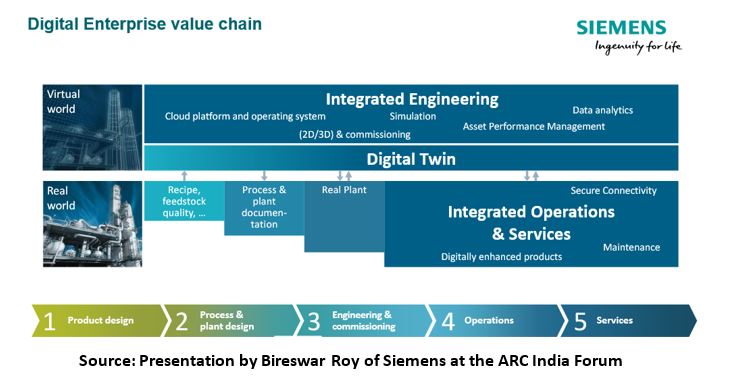

Siemens participated as a Global Sponsor at the ARC India virtual Forum Driving Digital Transformation in Industry and Cities on September 8-9, 2020. The current pandemic has changed the way events are hosted the world over. The physical has given way to the virtual; and for the very first time the ARC India Forum was hosted virtually. Like with all firsts, there were mixed feelings of excitement and apprehension. However, when we saw the 300+ attendees listening attentively to the informative presentations, we knew that our virtual Forum was the right platform to disseminate information, globally. This two-day virtual Forum provided end users, solution providers and decision makers an opportunity to learn from each other and get an overall view of the market and its requirements.
Bireswar Roy, Head, Digital Enterprise Services, Digital Industries, Siemens India, said that in the last six months we’ve been going through unprecedented challenges, both in our personal lives and businesses. There’s been a dramatic change in how we communicate; earlier there was direct audience contact, now we make presentations from isolated rooms. He spoke about digital transformation in the present manufacturing scenario and the importance of making the right choices (understand, plan, implement). About 45 percent see the potential of Industrial IoT, but don’t know where to begin; 70 percent of all digital transformation projects do not reach their goals; and billions are wasted in wrong investments. The question to be asked is if change is being made with a particular intent, an objective, or just because it’s a trend? The fundamentals are still the same, he said. Digital transformation in the present manufacturing scenario is having the vision to combine digital intent (efficiency, growth, improved quality, and shorter time-to-market) with digital capabilities (technology and infrastructure, data and analytics, organization, and actions).
Further, he spoke about the digital enterprise value chain and how the digital twin merges the real and virtual worlds. The digital twin makes it possible to simulate, test, and validate in a virtual environment, and then deploy on the shop floor or production environment. Siemens has a distinct view of what comprises a comprehensive digital twin, and that is a precise virtual representation of a physical product or process used across its lifecycle to simulate, predict, and optimize the product and the production system. A digital twin is made up of multiple representations or models for different aspects of physical behavior and an evolving object that needs to be managed across the lifecycle. And lastly, a closed-loop digital twin provides for bi-directional connectivity between the physical asset and the virtual model.

He explained the layers of interconnected plant automation architecture and the digital transformation modules. The backbone of this digital transformation journey includes IT infrastructure, networking, cybersecurity, sensors, asset integration, and vertical integration.
Digital transformation involves far more than just implementing new technologies. Cultural, workforce, and organizational issues also come into play and must be addressed effectively. To gain real value from digital transformation, it’s also important to have a plan for moving beyond the proof of concept and pilot stages to be able to scale up and roll out successful pilots across the business. Successful digital transformation of an organization “requires having a digital mindset with focus on agility and ownership culture,” he added. There has to be a cultural change that percolates throughout the organization by reskilling and upskilling, while encouraging and rewarding technology adoption. Mr. Roy concluded his presentation by showing a roadmap of the digital transformation journey, the key steps of which are:
Further, he spoke about the digital transformation milestones and the services provided by Siemens.

